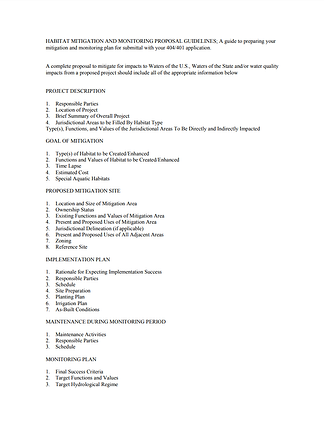In Lieu Fee Program
The Inland Empire Resource Conservation District is a non-regulatory public agency providing a variety of mitigation opportunities for project proponents in the region. This includes the District’s In-Lieu Fee (ILF) Program, a regional approach to fulfillment of mitigation responsibilities that allows permittee applicants (developers) the option to purchase stream and/or wetland mitigation credits to fulfill compensatory mitigation requirements for permitted impacts authorized under Sections 404 and 401 of the Clean Water Act. The Program offers a range of credits available for purchase by developers to address impacts occurring throughout most of the Santa Ana River watershed. Once permits are purchased, the IERCD’s ILF program administrators place the credits or acreage over properties owned or controlled by the IERCD that support aquatic resources, followed by actions taken to initiate the reestablishment, rehabilitation, enhancement, and/or preservation process.
FAQs
What is Compensatory Mitigation?
Prior to construction or development, impacts associated with jurisdictional wetlands or areas that fall under the definition of Waters of the United States (WOTUS) must be considered by the affiliated developers project proponents. After all appropriate and practicable steps have been taken, environmental threats must be identified and taken to avoid and/or minimize adverse impacts to the aquatic ecosystems. If additional impacts are projected beyond those minimized or eliminated, mitigation is required to offset any temporary and/or permanent impacts and disturbances. Regulatory agencies such as the United States Army Corps of Engineers (USACE), Environmental Protection Agency (EPA), and Regional Water Quality Control Board (RWQCB) review development project proposals, consider potential impacts to jurisdictional habitat, provide permits allowing projects to proceed conditionally to completion of mitigation requirements, and assign the amount of mitigation acreage or credits that need to be purchased by developers. Ultimately, the overall goal of assigning mitigation to developers is to ensure no net loss of aquatic resources within the area. Developers typically have several options to successfully complete mitigation requirements assigned by regulatory agencies including the purchase of credits via completion of mitigation through banks (e.g. mitigation banks), the purchase of credits from an In-Lieu Fee Program, or the pursuit of Permittee-Responsible Mitigation through in-lieu fee programs, and/or permittee-responsible projects.
Who can participate in the IERCD ILF Program?
Permittee applicants (developers) whose associated impacts exist within the boundaries of the IERCD’s ILF service area have the opportunity to purchase stream and/or wetland mitigation credits to fulfill compensatory mitigation requirements for permitted impacts authorized under Sections 404 and 401 of the Clean Water Act. Any impacts within the San Diego Creek Watershed or otherwise outside of the Santa Ana River watershed are not authorized to purchase credits from the IERCD’s ILF program.
Credit Descriptions & Pricing
Reestablishment Credit - $323,000/Acre
Reestablishment involves the manipulation of the physical, chemical, and/or biological characteristics of a site with the goal of returning natural/historic functions to a former aquatic resource. Reestablishment results in rebuilding a former aquatic resource and results in a gain in aquatic resource area, functions, and services.
Rehabilitation Credit - $289,000/Acre
Rehabilitation involves the manipulation of the physical, chemical, or biological characteristics of a site with the goal of returning natural/historic functions to a former or degraded aquatic resource. Rehabilitation results in a gain in aquatic resource function but does not result in a gain in aquatic resource area.
Enhancement Credit - $258,000/Acre
Enhancement involves the manipulation of the physical, chemical, or biological characteristics of an aquatic resource to heighten, intensify, or improve specific aquatic function(s). Enhancement results in the gain of aquatic resource functions but does not result in the gain in aquatic resource area.
Preservation Credit - $183,000/Acre
Preservation involves the conservation of existing ecologically important wildlife, habitat or other ecosystem resources in perpetuity.
Benefits of an ILF Program
- Selecting mitigation project sites using a watershed approach that looks at locally identified needs, local watershed plans and other conservation priorities.
- Providing flexibility to combine mitigation needs from small project impacts into larger, more sustainable aquatic resource restoration projects.
- Providing a better opportunity at mitigation success to the service area by having an ILF sponsor that is experienced in completing restoration projects and carry out the mitigation plan.
- Providing permanent protection—the regulatory agencies require mechanisms for long-term protection, management, and maintenance of the project sites as well as funding for long-term management.
Resources: click to download




